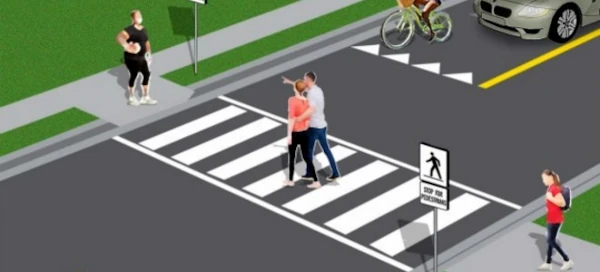 This case involves a crosswalk on 160th Street about 130 metres south of 96th Avenue in Surrey. Two young teenagers entered the marked crosswalk and were struck by a passing motorist. The issue to be decided was whether the teens should have waited for the car to pass instead of entering the crosswalk.
This case involves a crosswalk on 160th Street about 130 metres south of 96th Avenue in Surrey. Two young teenagers entered the marked crosswalk and were struck by a passing motorist. The issue to be decided was whether the teens should have waited for the car to pass instead of entering the crosswalk.
Circumstances of the Collision
Ms. Panganiban, aged 14, was walking home from school with a friend and began to cross 160th Street in the marked crosswalk. Ms. Sovdat was driving southbound on 160th Street and collided with the two pedestrians. Ms. Sovdat denied liability for the collision stating that the girls had walked in front of her when she was so close that she could not avoid striking them.
The Law on Using a Crosswalk
179 (1) Subject to section 180, the driver of a vehicle must yield the right of way to a pedestrian where traffic control signals are not in place or not in operation when the pedestrian is crossing the highway in a crosswalk and the pedestrian is on the half of the highway on which the vehicle is travelling, or is approaching so closely from the other half of the highway that the pedestrian is in danger.
(2) A pedestrian must not leave a curb or other place of safety and move into the path of a vehicle that is so close it is impracticable for the driver to yield the right of way.

Justice Elwood examines rights of way between vehicles and pedestrians at marked crosswalks in this case.
He found that the girls did step into the crosswalk when Ms. Sovdat was so close that it was impractical for her to stop and that Ms. Sovdat had the right of way.
However, he also found that Ms. Sovdat breached her duty of care by placing herself in a position where she was unable to stop for Ms. Naqvi and Ms. Panganiban.
The Court's Decision
Liability for the collision was apportioned at 80% for the driver and 20% for the pedestrians.
Learn More
Share This Article
The only surprise here is that a motorist was found 80% at fault. You have pedestrians, probably without legal councel, versus the ICBC with high priced legal councel. Deciding between the parties are the police who, outside their work as police, are almost certainly customers of the ICBC (for whom more liability for motorists will ultimately increase their personal insurance rates) and a justice who also, outside his work as a justice, is almost certainly a customer of the ICBC (so with the same apparent conflict of interest as the police).
Unless this case is not correctly reported here, the decision does not even follow the Motor Vehicle Act. The Act states (179 2):
A pedestrian must not leave a curb or other place of safety and walk or run into the path of a vehicle that is so close it is impracticable for the driver to yield the right of way.
So, if correctly cited, Justice Elwood's decision "that the girls did step into the crosswalk when Ms. Sovdat was so close that it was impractical for her to stop..." is ultra vires. Legally, 'impractical' is quite different than 'impracticable', 'impractical' essentially means reasonably convenient, while 'impracticable' means incapable of being performed or accomplished by the means employed (i.e., in operating a motor vehicle).
One imagines that were the victims not 14 year old girls, but rather adult men, that liability for the driver would not have been apportioned at as much as 80%. While the details of the case are not given, it is hard to imagine that someone who was not a motorist first (and a police officer or a justice second) would give motor vehicle operators convenience any weight in apportioning fault.
- Log in to post comments
- Log in to post comments

Seriously, pedestrians (and cyclists), motorists, and the law